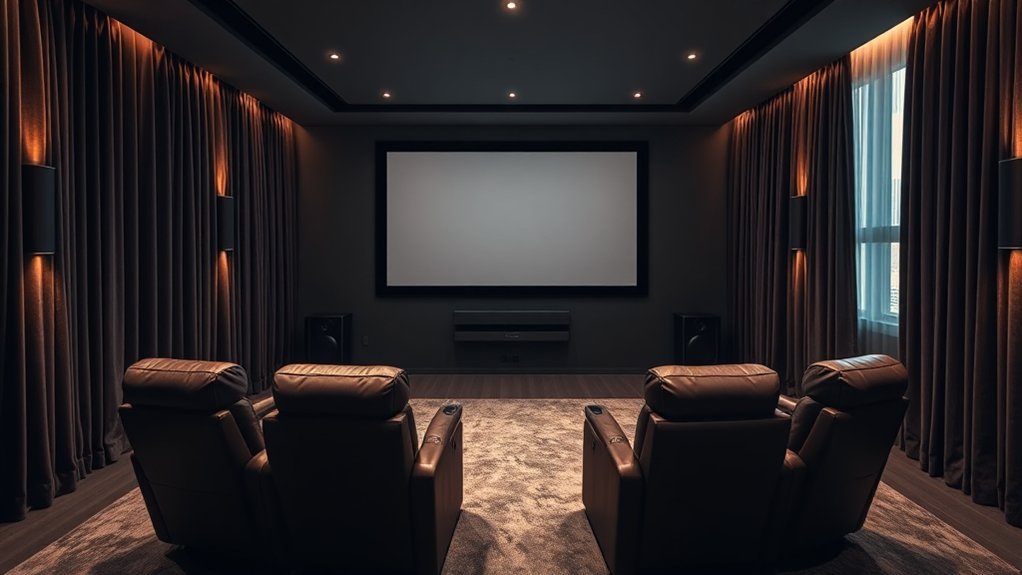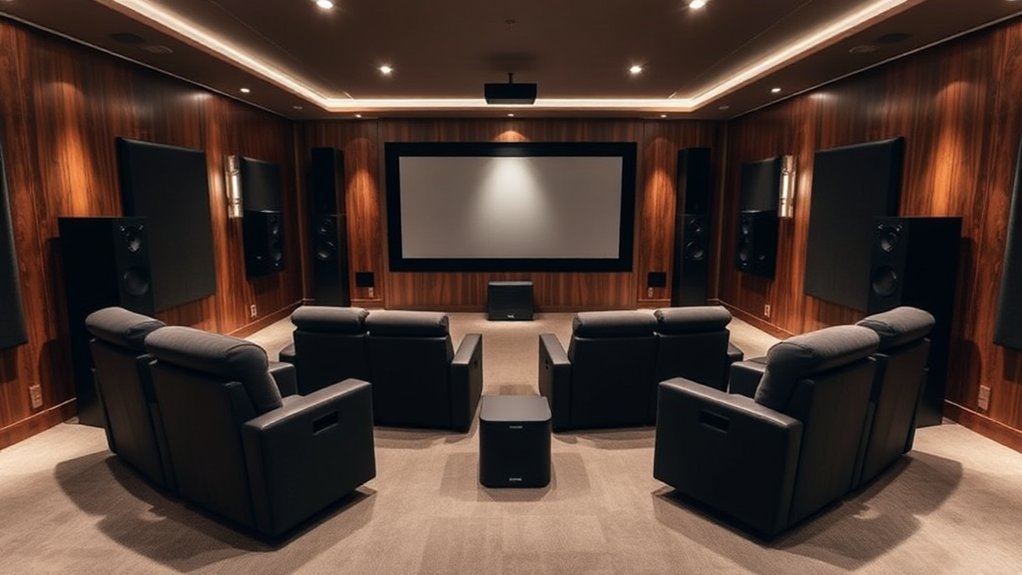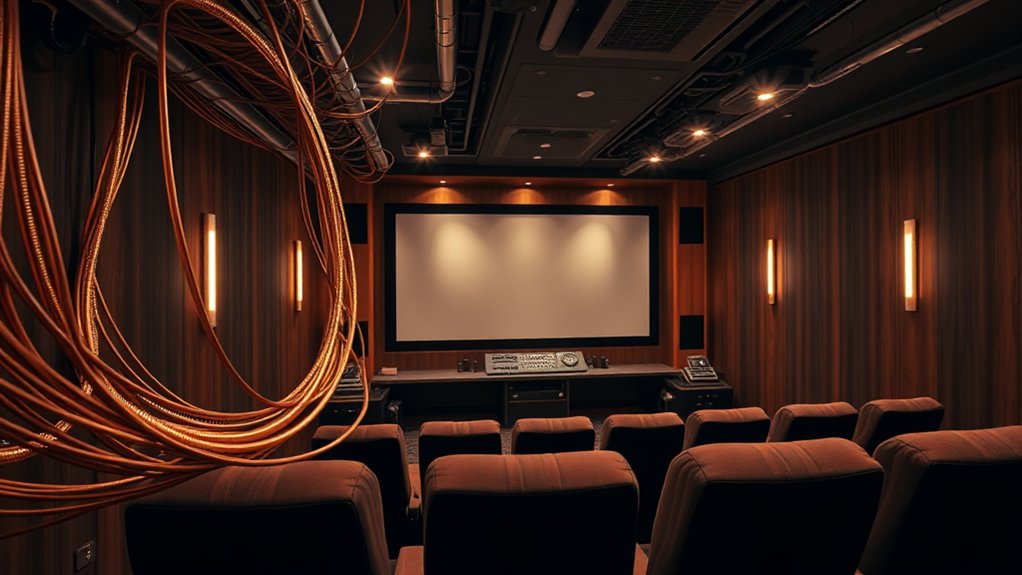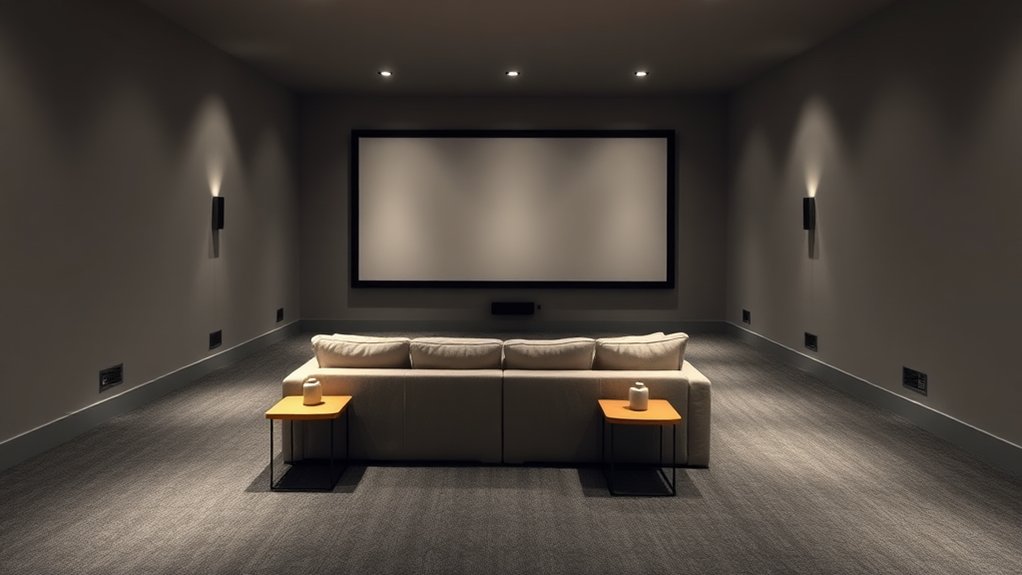To soundproof your home theater room, start by upgrading your walls and ceilings with decoupled or staggered stud constructions. Then, swap hollow core doors for solid options and seal gaps using acoustical caulk. Adding double-glazed windows and heavy curtains helps too. Don’t forget acoustic panels—they play an essential role when installed correctly, covering about 20-30% of your walls. Finally, think about flooring; carpets and area rugs minimize noise bounce. Curious about the finer details? There’s plenty more to investigate!
Key Highlights
- Use decoupled double stud or staggered stud walls to enhance sound isolation without compromising too much space.
- Upgrade to solid-core doors and apply acoustic sealants around frames to minimize noise leakage.
- Install double-glazed windows and heavy curtains to significantly reduce external noise interference.
- Add multiple layers of drywall combined with sound-dampening compounds to improve overall soundproofing effectiveness.
- Opt for carpeting and thicker pad materials to absorb sound waves and reduce echoes in the home theater.
Wall and Ceiling Treatments
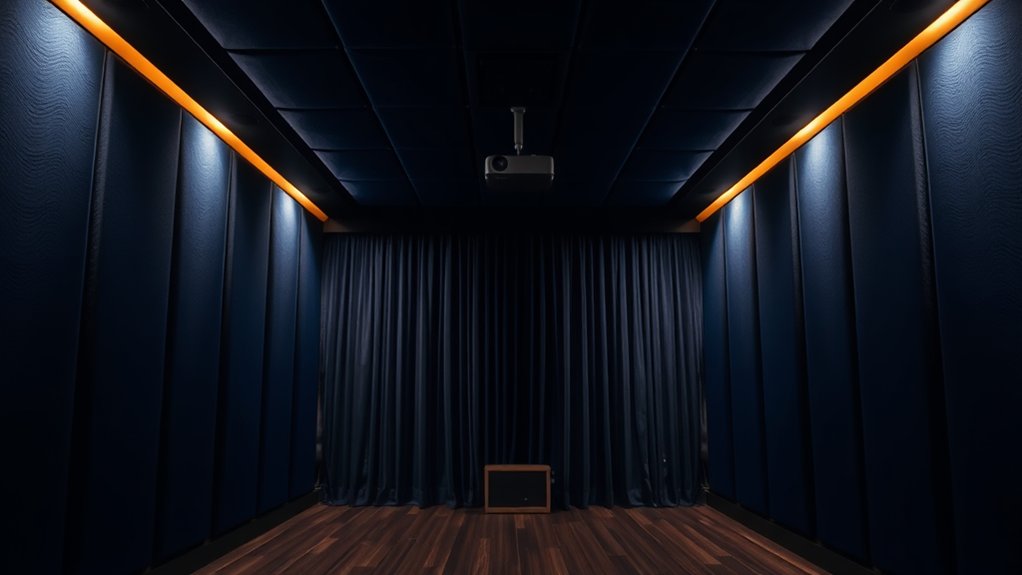
In the context of optimizing your home theater room, the right wall and ceiling treatments can make all the difference—think of it as the unsung hero of soundproofing!
You’ll want to start by considering decoupled double stud walls, which provide excellent sound isolation but do eat up some space. Want to save room? Staggered stud walls offer a great compromise.
Don’t forget to use double layers of drywall with damping compounds like Green Glue; this combo not only adds mass but likewise converts vibrations into heat, effectively reducing sound transmission. Soundproofing materials typically exhibit specific STC values that affect their effectiveness, making the choice of materials significant for optimal results. Additionally, employing multiple layers of drywall can significantly improve soundproofing when combined with sound-dampening techniques.
Using double layers of drywall with Green Glue can significantly enhance sound isolation by converting vibrations into heat.
For wall insulation, standard fiberglass beats foam, trapping sound waves effectively.
And if you’re feeling adventurous, installing sound isolation clips with hat channel systems can create a fortress against outside noise—who wouldn’t want that?
Upgrading Doors and Windows
Once you’ve tackled the walls and ceiling of your home theater, it’s time to shift focus to the doors and windows—those often-overlooked entry points for sound transmission that can undermine all your hard work.
Start by swapping out hollow core doors for solid core options; the added mass blocks sound far better. If you really want to go the extra mile, consider applying mass loaded vinyl for even greater sound insulation. Closing gaps around the door frames with neoprene or good old acoustical caulk is also essential to minimize noise leakage. Additionally, addressing noise pollution is critical as it can contribute to serious health issues over time.
And for your windows? Double-glazed glass works wonders, whereas heavy curtains can absorb that annoying external noise.
Isn’t it amazing how a few upgrades can transform your experience?
Acoustic Panel Installation
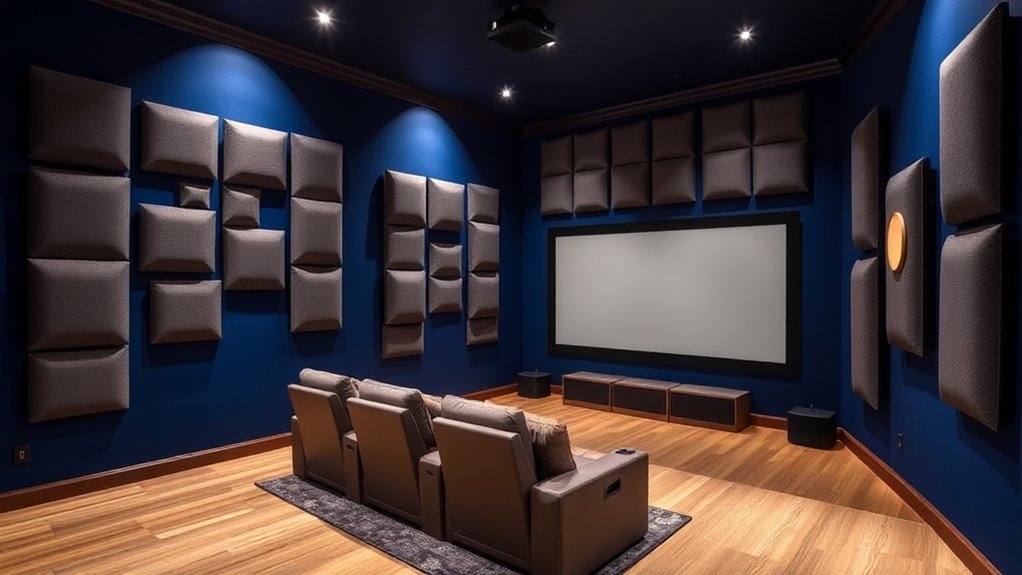
Installing acoustic panels in your home theater can truly improve the audio experience, transforming your space into a sound haven.
First, make certain your walls and ceilings are clean and dry, as dust or debris could hinder adhesion. Gather your tools—screws, adhesive, and a level—to prepare for an effective installation.
Next, measure and mark where you’ll position the panels. Think about the room’s shape and speaker locations to find the best spots for sound absorption. Consider following the 20-30% rule for coverage of wall space to achieve desired sound control.
Measure and mark your panel placements, considering the room’s layout and speaker positions for optimal sound absorption.
For lighter panels, adhesive methods work well, whereas heavier ones might need trusty Z-clips or brackets. And remember, avoid gaps—those annoying air pockets can ruin your acoustics.
Flooring Solutions
To create the ultimate home theater experience, you’ll want to pay careful attention to your flooring solution—after all, the wrong choice could send sound bouncing off walls like a pinball, ruining your carefully curated audio setup.
Carpeting is your best bet, as it absorbs sound waves effectively, reducing echoes and improving audio clarity. Pair it with a thick carpet pad for added insulation, as who wants to hear the cat’s late-night adventures through the ceiling?
If hard flooring is unavoidable, consider adding area rugs to mitigate sound reflection.
Sealing and Noise Prevention Techniques
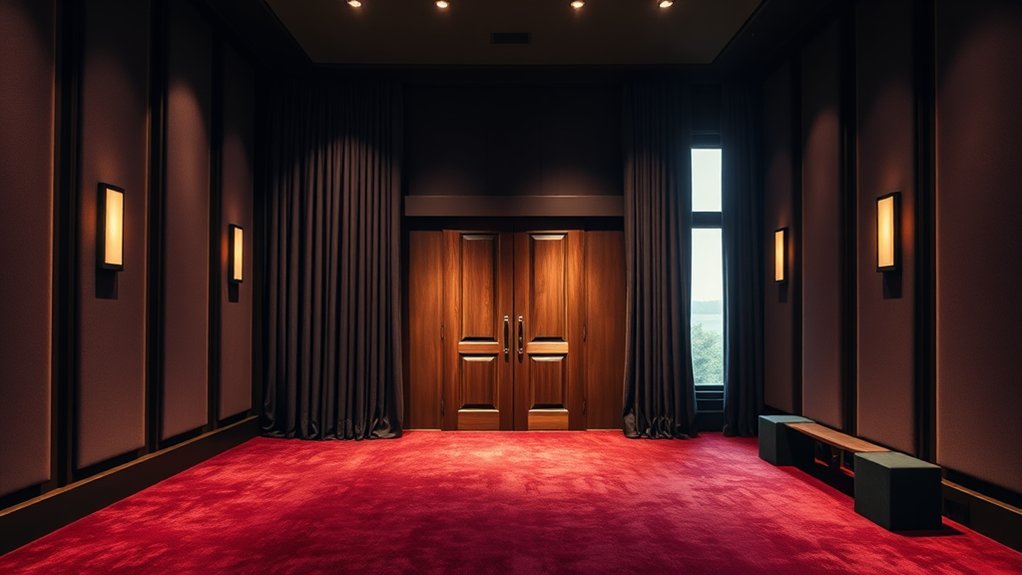
As you might dream of an immersive movie experience without interruptions from the outside world, soundproofing your home theater room requires a strategic approach to sealing and noise prevention techniques.
Start by decoupling your walls—this isolates them from the studs, reducing bothersome vibrations. Floating wall systems can be your ally, creating space to block sound waves, particularly those troublesome low frequencies.
Don’t forget acoustic sealants to meticulously fill every crack and seam, since sound loves to sneak through small openings. For windows, consider double-pane glass and sound-damping curtains—who knew heavy drapes could be so functional?
Finally, solid-core doors and door sweeps prevent sound leaks. After all, you want your cinematic escape to feel like a fortress, right?
Frequently Asked Questions
How Does Room Shape Affect Soundproofing Effectiveness?
Room shape greatly impacts soundproofing effectiveness. If your room’s irregular, you’ll face unpredictable sound reflections. Symmetrical shapes could amplify resonance issues, so you’ll need tailored strategies to effectively minimize sound leakage and improve overall acoustics.
What Materials Are Best for DIY Soundproofing Projects?
For DIY soundproofing projects, you’ll find acoustic fiberglass panels, mass loaded vinyl, and acoustic sealants incredibly effective. Combine these with door sweeps and heavy curtains for maximum noise reduction and a quieter environment.
Can I Soundproof Without Extensive Renovations?
Yes, you can soundproof without extensive renovations. Use removable materials like window plugs, acoustic panels, and heavy curtains. Seal gaps with caulk, and add mass with soundproof mats or rugs to effectively minimize noise.
How Much Does Professional Soundproofing Cost on Average?
Professional soundproofing costs between $1,400 and $9,000 on average, depending on room size, materials, and installation complexity. You’ll find prices can vary considerably based on the level of sound isolation you desire.
Are There Specific Soundproofing Techniques for Bass-Heavy Setups?
For bass-heavy setups, you’ll want to use resilient channels to minimize vibrations, install thick drywall, and add bass traps in corners. Don’t forget to seal gaps with acoustic sealant for ideal sound isolation.

